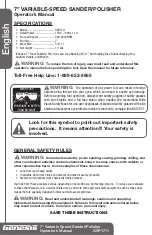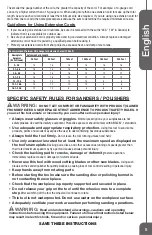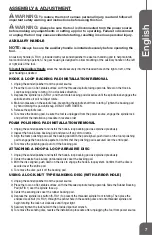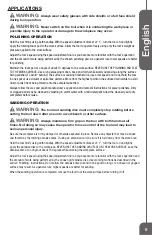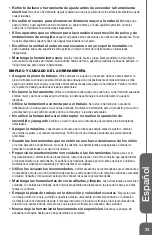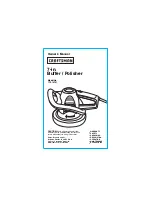
English
7" Variable Speed Sander/Polisher
Operator’s Manual GSP1711
USING A SELF-ADHESIVE SANDING DISC (NO ARBOR HOLE)
1) unplug the sander/polisher from the power source.
2) Place the tool on a flat stable surface, with the threaded spindle facing upwards. Slide the Rubber Backing
Pad (8-FIG 1) over the spindle face up.
3) Depress the spindle lock button (5-FIG 1) to prevent the threaded spindle from rotating. Then place the Lock
Nut (10-FIG 1) onto the threaded spindle and begin rotating the lock nut clockwise until finger tight.
4) Securely tighten the lock nut with the provided spanner wrench.
5) Center the self-adhesive sanding disc on rubber backing pad and press firmly.
6) To remove the sanding disc, pull the sanding disc off the rubber backing pad.
OPERATION
WARNING:
Always be sure the tool is disconnected from the power source
before making any adjustments or setting up. Failure to disconnect or unplug the tool
may cause accidental starting, resulting in serious personal injury.
NOTE:
Always Check that the power supply corresponds to the voltage on the ratings
plate.
WARNING:
To avoid accidental start, Check to make sure Lock-on button is
not engaged prior to plugging in tool and your finger is not touching the switch.
WARNING:
Never depress the Spindle Lock when the spindle is moving.
SWITCH OPERATION
To Start the Tool,
depress the on/off switch (1-FIG 1) .
To Stop the Tool,
release the switch.
The tool can be locked on by depressing the Lock-on button (2-FIG 1) and the on/off switch (1-FIG 1) at the same
time, then releasing pressure on the on/off switch. The lock-on feature is to relieve fatigue on the trigger finger
only. To release the lock on button, simply depress the on/off switch.
CAUTION:
Grip the tool firmly at all times while it is running, and keep both hands away from the Sanding/
Polishing wheel.
SPEED ADJUSTMENT DIAL
The speed adjustment dial (3-FIG 1) is located on top of the rear handle. In this position, slightly forward of the
on/off switch, the sander/polisher’s speed is easily adjusted by the operator’s thumb on the hand grasping the
tool by the rear handle.
With the on/off trigger switch fully depressed and the tool running,
the tool speed can be changed by rotating the speed adjustment
dial to a numbered setting from 1 to 6. The tool speed increases as
the dial is moved in the direction of the number 6 and lower speed
is obtained as the dial is turned towards the number 1.
Refer to the Table 1 for the relationship between the number
settings on the dial and the approximate tool speed.
To ensure operator control, the tool should always be turned “oN”
with the speed adjustment dial in the number 1 position.
CAUTION:
Continuous operation of the tool at low speeds for a long time will cause the motor to become
overheated, possibly resulting in malfunction or tool failure. To cool the motor, occasionally run the tool at high RPM
under no load for short periods of time allowing the tool’s fan to cool the motor. Be careful not to obstruct the air
vents located in the forward gear housing or in the rear handle, near the trigger switch.
CAUTION:
The speed adjustment dial can only be rotated as far back as the number 1 or forward to the
number 6. Do NoT attempt forcing the dial beyond the numbers 1 or 6, or the speed adjustment dial will be
damaged and no longer function.
NUMBER
RPM
1
600
2
900
3
1500
4
2100
5
2700
6
3000
TABLE 1


